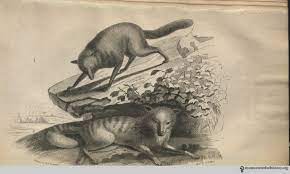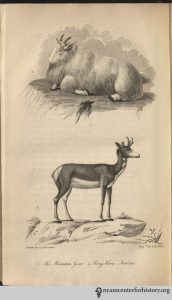This museum holds the American Natural History Book Part 1. It was written between 1826 to 1828. The artist of the book is Godman, John D. Godman was a physician, sailor, professor, and author. He studied medicine and anatomy at the University of Maryland. He became a professor of surgery at the Medical College of Ohio then become a professor of anatomy at Ruger’s medical college.[1] This author traveled through America, exploring different lands, and was able to document what animals Am erica has. The artist got up close enough to the animals to be able to depict what the animals look like in detail. The artist shows different angles of most animals to give us a better picture of what the animals looked like. The author created the American Natural History Book Part 1 to spread information about animals and what they look like. This helped document which animals were on America’s lands. This document is important because people wanted to know the animals
erica has. The artist got up close enough to the animals to be able to depict what the animals look like in detail. The artist shows different angles of most animals to give us a better picture of what the animals looked like. The author created the American Natural History Book Part 1 to spread information about animals and what they look like. This helped document which animals were on America’s lands. This document is important because people wanted to know the animals
that were on the land. They wanted to know which animals were dangerous and which were friendly. Many people have not seen all the animals in America and through these drawings were able to learn about animals they have never seen before. During the 19 century, there was a rise of naturalists studying animals and America’s nature. Alexander Von Humboldt is another well-known naturist that was extremely successful during the 19 century because his work was significant. Both Humboldt and Godman’s research have affected scientists, explorers, and geological surveyors. They helped people understand the environment.[2] There was a huge call for this type of work, but once World War 1 and World War 11 came people were less focused on animals.[3] Godman piece is important to people now because it includes animals that are extinct such as the Mastodon. This piece tells us that during the 19th century A mericans did not know all the animals that existed in America and that people were learning about new animals through these depictions. Americans had lost a lot of valuable information on animals in the past, such as the loss of the North Pacific Exploring Expedition and other zoology reports because of the Civil war.[4] The fact that humanity still has Godman, John D art, and documentation to look back to is helpful. The documentation is helpful for everyday people, scientists, naturalists, and explorers. This artistic book includes amazing information that could have been lost.
mericans did not know all the animals that existed in America and that people were learning about new animals through these depictions. Americans had lost a lot of valuable information on animals in the past, such as the loss of the North Pacific Exploring Expedition and other zoology reports because of the Civil war.[4] The fact that humanity still has Godman, John D art, and documentation to look back to is helpful. The documentation is helpful for everyday people, scientists, naturalists, and explorers. This artistic book includes amazing information that could have been lost.
John D. Godman had many walks along the Wissahickon Creek in Germantown, Pennsylvania, his main exploration area. He also explored Baltimore, Wilmington, Delaware, and Chestertown, Maryland, Caribbean Islands, Anne Arundel County, and Ohio.[5]
This book includes drawings of animal bones. This book contains the names of the different animals. It has drawings that compare animals of the same species and the difference in the appearance of different species. It includes animals on land, in-flight, and in the sea. This artistic book contained animals of all shapes and sizes. It also includes the weapons used to capture a whale. When looking at the drawings, observers can tell that the animals come from different areas of the country and are not specific to one state. This book is important for the museum because it gives people an insight into what animals in America were known during the early 1800s. It also gives an insight into the view Americans had on animals in the past. America saw whales as useful materials, not as valuable animals to humanity’s environment. So, whales were hunted for whale bubbler which gave American’s oil.[6] Without this documentation, Americans could be more behind on animal discovery because fewer people would be made aware of certain animals in this book. There is another book American Natural History. Part 1- Mastology which includes a detailed description of the animals drawn by John D. Godman.
[1] Appletons Encyclopedia, ed., “Virtual American Biographies,” John D. Godman, 2021, http://www.famousamericans.net/johndgodman/.
[2] Kim Tolley, “Learning from Nature: Alexander Von Humboldt’s Influence on Young Women’s Geography and Natural History Education in Nineteenth-Century America,” Taylor & Francis, 2019, https://www.tandfonline.com/doi/full/10.1080/00309230.2019.1630448.
[3] Ronald Scott Vasile, “13,” in William Stimpson and the Golden Age of American Natural History (DeKalb: Northern Illinois University press, 2018), pp. 92-97.
[4] Ronald Scott Vasile, “13,” in William Stimpson and the Golden Age of American Natural History (DeKalb: Northern Illinois University press, 2018), pp. 92-97.
[5] Scott R Honeycutt, “Beautiful Day. Pleasant Walk: Walking and Landscape in the Works of Eswick E Orks of Eswick Evans, John D Ans, John D. Godman, Elizabeth F . Godman, Elizabeth Fries Ellet, and Ries Ellet, and Bradford Torrey,” May 5, 2012, pp. 92-97.
[6] “On the Water,” On the Water – Fishing for a Living, 1840-1920: Commercial Fishers > Whaling, 2021, https://americanhistory.si.edu/onthewater/exhibition/3_7.html#:~:text=American%20whaling%20flourished%20from%20the%20late%201700s%20through%20the%20mid%2D1800s.&text=Commercial%20whaling%20began%20in%20the,oil%20derived%20from%20whale%20blubber.